
About UsThe Numismatic Bibliomania Society is a non-profit organization promoting numismatic literature. For more information please see our web site at coinbooks.org SubscriptionsThose wishing to become new E-Sylum subscribers (or wishing to Unsubscribe) can go to the following web page link MembershipThere is a membership application available on the web site Membership Application To join, print the application and return it with your check to the address printed on the application. Membership is only $15 to addresses in the U.S., $20 for First Class mail, and $25 elsewhere. For those without web access, write to: David M. Sundman, Secretary/TreasurerNumismatic Bibliomania
Society AsylumFor Asylum mailing address changes and other membership questions, contact David at this email address: dsundman@LittletonCoin.com SubmissionsTo submit items for publication in The E-Sylum, just Reply to this message, or write to the Editor at this address: whomren@coinlibrary.com
BUY THE BOOK BEFORE THE COINYou won't regret it! |
- WAYNE'S WORDS: THE E-SYLUM SEPTEMBER 12, 2010
- KOLBE & FANNING ROBERT J. MYERS AUCTION CLOSES SEPTEMBER 16, 2010
- WHITMAN PUBLISHING PREVIEWS UPCOMING NUMISMATIC BOOK RELEASES
- 2010 NEW YORK TIMES LIBRARIAN AWARD NOMINATIONS OPEN
- WHITMAN PHILADELPHIA EXPO EDUCATIONAL PROGRAMS
- HOW TO OPEN A NEW BOOK
- ON THE QUESTIONABLE TERRITORIAL GOLD ITEMS REMOVED FROM THE RED BOOK
- MORE ON 100 GREATEST U. S. ERROR COINS
- MORE ON THE ROOSEVELT UNIVERSITY COURSE IN NUMISMATICS
- MORE ON THE WORST NUMISMATIC BOOKS (AND WHAT WE LOVE ABOUT ALL OF THEM)
- THE WASHINGTON POST ON BOOKS, LLC
- QUERY: GUTTAG PUBLICATION PICTURING NEW JERSEY COPPERS SOUGHT
- QUERY: PRICED COPY OF 1913 HENRIE BUCK SALE SOUGHT
- QUERY: TIDY HOUSE PRODUCTS AND PROMOTIONAL COINS INFORMATION SOUGHT
- THE BEST ANTI-PENNY RANT EVER?
- NOTES FROM E-SYLUM READERS: SEPTEMBER 12, 2010
- VIDEO ON EUROPEAN MONETARY UNIFICATIONS RELEASED
- ARABIC COINS OF THE MIDDLE AGES FOUND IN GERMANY
- LIVING SOLDIER TO RECEIVE MEDAL OF HONOR
- ARTICLE: DE LA RUE STAFF FALSIFIED BANKNOTE TEST RESULTS
- MAN'S DEFENSE: PHONY MONEY IS FOR ARTISTIC ENDEAVOR
- FEATURED WEB SITE: BARBERHALF.COM
WAYNE'S WORDS: THE E-SYLUM SEPTEMBER 12, 2010

Among our new subscribers this week is Jamie Yakes. Welcome aboard! We now have 1,372 subscribers.
This week we open with a reminder of the impending closing date for the Kolbe & Fanning sale of the Robert Myers library. BTW, their sale of the Anders Frösell library closes TODAY. Next, Whitman Publications outlines some of their upcoming new editions and titles.
Other topics this week include questionable coins removed from the Red Book, Guttag Brothers publications, the Henrie Buck collection and Barber Halves. To learn about jealous professors, the brutal pirate who was also an honored statesman, beautifully toned Tidy House coins, and How to Open a New Book, read on. Have a great week, everyone!
Wayne Homren
Numismatic Bibliomania Society
KOLBE & FANNING ROBERT J. MYERS AUCTION CLOSES SEPTEMBER 16, 2010
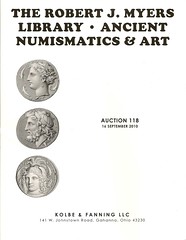 Kolbe & Fanning Numismatic Booksellers wish to remind E-Sylum readers that their auction of the Robert J. Myers numismatic library closes this Thursday, September 16. The Myers library features works on ancient numismatics, history and art, and is comprehensive for ancient Greek coins and includes many important works on Roman numismatics and other issues. Bids may be placed by phone at (614) 414-0855, fax at (614) 414-0860 or e-mail at df@numislit.com.
Kolbe & Fanning Numismatic Booksellers wish to remind E-Sylum readers that their auction of the Robert J. Myers numismatic library closes this Thursday, September 16. The Myers library features works on ancient numismatics, history and art, and is comprehensive for ancient Greek coins and includes many important works on Roman numismatics and other issues. Bids may be placed by phone at (614) 414-0855, fax at (614) 414-0860 or e-mail at df@numislit.com.
WHITMAN PUBLISHING PREVIEWS UPCOMING NUMISMATIC BOOK RELEASES
For Collectors and History Buffs of all Stripes
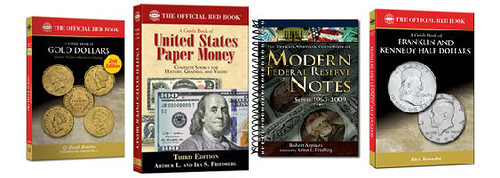
Autumn 2010 brings a veritable cornucopia of new books from Whitman Publishing. Coin collectors will find an updated new edition of the Guide Book of Gold Dollars, described by renowned gold expert David Akers as “a wonderful book—in fact, the finest that Dave Bowers has yet written in the Official Red Book series.” Rick Tomaska's Guide Book of Franklin and Kennedy Half Dollars will inform and delight aficionados of the modern fifty-cent piece. Paper-money collectors will benefit from the newest edition of the Guide Book of United States Paper Money, by Arthur and Ira Friedberg, a revised and updated version of their Whitman best-seller.
Robert Azpiazu's Modern Federal Reserve Notes, Series 1963–2009 awaits the collector of paper money's most popular notes—today's $1 through $100 bills, collectible from pocket change. We also have VAULT books on Ronald Reagan (whose 100th birthday is approaching) and on the modern (post-9/11) U.S. military. All of these books, and many more, are coming down the pike as we wrap up 2010 and ring in 2011. . . . but we won't give away all the surprises yet! Stay tuned to The Whitman Review for more news and announcements.
To read the complete article, see: A Shelf of Upcoming Books (www.WhitmanReview.com)
2010 NEW YORK TIMES LIBRARIAN AWARD NOMINATIONS OPEN

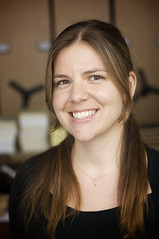
The New York Times is once again hosting their annual librarian award contest. As the ANS is a library that is freely open to the public, I am passing out the link in the hope that I might get some nominations from our users. Of course it would be great for me personally, but I also think it would be an excellent opportunity to reach a much wider audience by letting people know who we are and what resources are available. If E-Sylum readers have time before the September 20 deadline, I would be delighted for nominations!
The link is here: www.ilovelibraries.org/lovemylibrarian/public.cfm
There are five short questions. Some info you will need:
Name of nominee: Elizabeth Hahn
Name of Library Branch = American Numismatic Society Library (New York, NY)
Librarian's email: hahn@numismatics.org
THE BOOK BAZARRE
THE AUCTION SALE OF THE ANDERS FRÖSELL LIBRARY
CLOSES ON SEPTEMBER 12, 2010
THE AUCTION SALE OF THE ROBERT J. MYERS LIBRARY
CLOSES ON SEPTEMBER 16, 2010
(614) 414-0855 • df@numislit.com • GFK@numislit.com
WHITMAN PHILADELPHIA EXPO EDUCATIONAL PROGRAMS

The First United States Mint: Visual Presentation and Walking Tour of the Mint and its Neighborhood. Authors Len Augsburger and Joel Orosz uncovered a treasure trove of visual documentation of the first U.S. Mint in the form of the Stewart Archive. They will present images from their forthcoming book, "Pictures of the First United States Mint: The Numismatic Legacy of Frank H. Stewart" and then lead an informative walking tour of the Mint site and the surrounding historic neighborhood. Friday, October 1 at 1pm in Room 305.
Len Augsburger adds:
The tour will conclude at Congress Hall with an exhibition of a number of items from the Frank H. Stewart Old Mint collection, which was bequeated to the city of Philadelphia upon Stewart's death in 1948. The collection is today administered by Independence Hall National Historical Park.
Chief Engraver of the U.S. Mint, John M. Mercanti. The thirteenth Chief Engraver of the U.S. Mint, Mr. Mercanti has produced more coin and medal designs than any other employee in Mint history. He will lead a discussion about numismatic engraving techniques and artistry and how these have changed in the past 100 years. "Art Meets Technology: Transforming Saint Gaudens Gold from 1907 to 2009. " Saturday, October 2, 2010 at 11am in Room 305.
U.S. Mint's Greatest Errors. Nicholas Brown and David Camire, co-authors of 100 Greatest U.S. Error Coins will present highlights from his book, recently published by Whitman Publishing. From broadstrikes to brockages, Brown takes you behind the scenes of the U.S. Mint and shows you where it all went wrong on the top U.S. error coins of all time. Friday, October 1 at 3pm and Saturday, October 2 at 10am in Room 305.
Tales of the Brutal Pirate Who Was Also an Honored Statesman. Tom Sebring tells the amazing tale of Henry Morgan, the pirate who, upon his death, was given a 21 gun salute by ships of the British Royal Navy. Saturday, October 2 at 1pm in Room 305.
Show Me the (Paper) Money: An Expert Q&A Panel Led by Q. David Bowers. Bring your most obscure questions about paper money to a stellar group of experts led by Q. David Bowers. Friday, October 1 at 9am in Room 305.
The Constitutional Experience, with Thomas Jefferson and Alexander Hamilton as portrayed by the remarkable actors Steven Edenbo and Ian Rose. If you've been lucky enough to see them at American Historical Theatre, you know that Edenbo and Rose bring Jefferson and Hamilton (and their conflicting views on to the U.S. Constitution) to life in a way that has to be seen to be believed. Friday, October 1 at 11am at Room 305.
Royal Portraits: Medals of the German Empire, with Dennis Tucker. In the 1800s and early 1900s, thousands of different medals were struck to celebrate the German royal and imperial families. What do these regal portraits tell us about Germany and the German people? And as the Empire began to fall apart during World War I, how did those messages change? Award-winning researcher and writer Tucker will share images from his collection in this richly illustrated presentation. Friday, October 1 at 12pm and Saturday, October 2 at 12pm in Room 305.
Having Fun Collecting Colonial Paper Money on a Budget, with Ray Williams. Mr. Williams, president of the Colonial Coin Collectors shifts his focus to paper money from the period and tells you how to have fun within that subgenre without busting the budget. Saturday, October 2 at 3pm in Room 305.
All meeting room locations are in the Pennsylvania Convention Center unless otherwise noted. All times are EDT.
Visit WhitmanCoinCollecting.com and click on Philadelphia Expo for the latest updates. Register for free at WhitmanExpo.com.
The Whitman Coin & Collectibles Philadelphia Expo is open to the public free of charge from Noon until 6:00pm on Thursday, September 30 and from 10am until 6pm on Friday and Saturday, October 1 and 2. "Early Birds" are allowed onto the bourse floor at 10am on Thursday and at 9am on Friday and Saturday for a fee of $75.
HOW TO OPEN A NEW BOOK
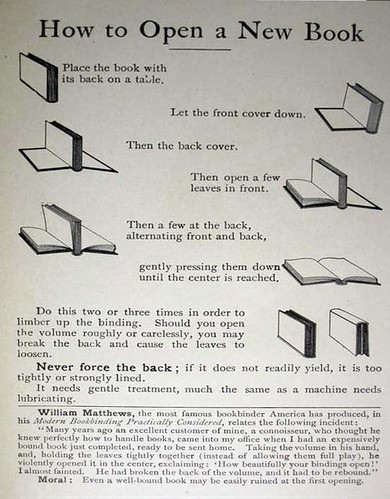
Doesn't everyone do it like this? (Being from a family of librarians might have clouded my mind.)
It causes me physical pain when I see people reading a paperback with the front cover folded all the way behind the back cover. It's their book, but I just want to take it and stroke it and say, "there, there, they didn't know they were hurting you."
What's a "book"?
To read the complete article, see: How to open a new book (www.boingboing.net/2010/09/06/how-to-open-a-new-bo.html)
THE BOOK BAZARRE
ON THE QUESTIONABLE TERRITORIAL GOLD ITEMS REMOVED FROM THE RED BOOK
Tom DeLorey writes:
Regarding John J. Ford and his "alleged" counterfeits, back around late 1974 or so I saw a letter that Ford had written to Courtney L. Coffing, then the Editor of The Numismatic Scrapbook Magazine, concerning several purported territorial gold items that had been listed in the Redbook in the early 1960's, but were subsequently removed.
Ford wrote, with what I assume was the verbal equivalent of a straight face, that the items had been removed from the Redbook "for lack of space." Subsequent Redbook Editor Ken Bressett informs me that this was not the case.
To read the earlier E-Sylum article, see: MORE ON THE 1966 ANA PNG ARBITRATION HEARING (www.coinbooks.org/esylum_v13n36a05.html)
MORE ON 100 GREATEST U. S. ERROR COINS
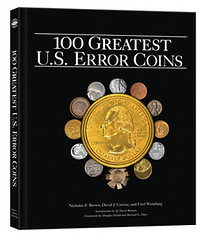 In last week's review of “100 Greatest U. S. Error Coins,” I wrote:
In last week's review of “100 Greatest U. S. Error Coins,” I wrote:
For example, #99 on the list is a 1974 Jefferson Nickel struck on a 1973 Jefferson Nickel. 2010 price estimate? $15,000-$17,500! ... Yes, those are the right number of zeros.
Jonathan Brecher writes:
Actually, those *aren't* the right number of zeros. In an odd coincidence, that very coin sold last month at Heritage for under $2,200. I looked at the book at the ANA show, and I definitely agree that the errors are spectacular. I expect I will be getting a copy for my own bookshelf eventually. In my impression, however, the prices listed are retail prices, and very strong ones at that.
Of course, since it's rather unlikely that someone will come up with another example of any of those pieces, the prices might be considered a minor detail. Enjoy the pictures!
To view the complete lot description, see: (coins.ha.com/common/view_item.php?Sale_No=1143&Lot_No=5571)
To read the earlier E-Sylum article, see: BOOK REVIEW: 100 GREATEST U. S. ERROR COINS (www.coinbooks.org/esylum_v13n36a03.html)
MORE ON THE ROOSEVELT UNIVERSITY COURSE IN NUMISMATICS
Belatedly I started catching up on my E-Sylum articles and noticed that there were inquiries concerning the Roosevelt University Course in Numismatics. Ken Bressett answered most of the questions except why it was not renewed the second year. Although I was not old enough to attend at the time, my brother did. The program was started at Roosevelt U. because that is where my brother was attending.
While quite popular, my understanding is that other professors were jealous and sabotaged the course that did not feature any of the school professors. Unfortunately academic politics can be as nasty as its government counterpart.
Perhaps we should consider reviving a similar program someday…..
And of course, it would be wonderful to have a university-level course in numismatics in this country again. How could it be done to avoid the pitfalls that befell the Roosevelt University program? -Editor
To read the earlier E-Sylum article, see: THE 1966 ANA PNG ARBITRATION HEARING AND ROOSEVELT UNIVERSITY (www.coinbooks.org/esylum_v13n35a17.html)
MORE ON THE WORST NUMISMATIC BOOKS (AND WHAT WE LOVE ABOUT ALL OF THEM)
Jonathan Brecher writes:
Surely any discussion of the worst numismatic books must include the many editions of Frank G. Spadone's "Major Variety and Oddity Guide of United States Coins", published in massive quantities from the 1960s into the early 1980s. Unlike the "100 Greatest" books on error coins reviewed recently, the Spadone book shows example after example of pieces that show nothing more than post-mint damage. To make matters worse, the book also shows enough legitimate errors that it is very difficult for a beginning (or intermediate!) collector to tell the real errors from the fantasies.
Fortunately, the Spadone book is slowly drifting towards numismatic obscurity, and most of the remaining references to it on Google are careful to point out how bad it is. Even so, there are at least seven copies currently available for purchase on eBay, and at least one listing Spadone as a reference in touting a coin slabbed by NCS for environmental damage
To view the eBay lot description, see: 1959 Jefferson Nickel ——> LOOKS LIKE A "BLACK BEAUTY"!! (cgi.ebay.com/ws/eBayISAPI.dll?ViewItem&item=370376057556)
Wayne Schroll writes:
I must admit when I first saw your call for worst numismatic book nominations I was afraid that this was going to turn into a real mud-slinging festival. Everyone has an opinion and people like to take shots at the guy on top; that sort of thing. But it didn't. And I was relieved to learn that apparently my fellow numismatic bibliophiles seem to share my opinion about numismatic authors to some degree.
There are some very talented and prolific writers that produce excellent book after book. And there are some writers that make their best, though not-quite-as-talented, effort at a book about some area concerning coins that fascinated them. And maybe some of those books just aren't all that great from a literary point of view. But in the end, all these books share a common foundation and a common goal. They try to tell the rest of us an interesting story about coins and their history and how those things tell us something about the way we are now and where we came from. No matter how poorly told the tale may be, there just might be something in it that we can each learn from.
Certainly there are a couple examples of books where people just seemed to have made it up as they went along, and these can easily be ignored. But when it's all said and done, I can't think of a coin book that I regret spending time reading.
Joe Boling writes:
Our editor says "As a bibliophile I've only rarely met a book I didn't find something to love about." Amen, brother, and I'm not even a bibliophile.
Twice I have made multi-carton donations to the American Numismatic Association library from my own - in 2001 and 2006, both years when I sold major parts of my collections and I needed offsetting tax deductions. I was ready to sell the collections (I had mined them for all the information and pleasure I expected to be able to extract from them). But as I prepared the books for shipping, individually wrapping them (and inventorying them for the tax documents), I found I was far from ready to be rid of many of them - there was much more to learn from them. It was painful.
Then over the years since, as people have asked me to attribute and authenticate items previously in my specialty (Japan), I found I needed some of the books I had donated, and I have had to replace them (at prices higher than the deductions I took when I donated them). More pain. Yes, I could borrow them from ANA, but you all know that that is a distant third choice in terms of access.
So although I still intend for ANA to have the rest of my library (I barely touched the Asian-language parts of it in my first donations), I expect it to be a long time from now. There is just too much value in the contents of these books to part with them.
At least one reader however, was disappointed - subscriber #1 no less, Peter Gaspar, who writes:
 I was disappointed at your accepting nominations for worst numismatic book. One objection to this topic is that it is bound to attract smear campaigns as it did this week when a book on ancient Jewish coins was condemned because it presented theories to which the nominator objected. If an E-Sylum participant doesn't like a book, he or she is free to write a negative review, which should contain arguments supporting a negative (or positive) opinion. But to call a book bad on no stronger basis than someone else's negative review is in my view inappropriate.
I was disappointed at your accepting nominations for worst numismatic book. One objection to this topic is that it is bound to attract smear campaigns as it did this week when a book on ancient Jewish coins was condemned because it presented theories to which the nominator objected. If an E-Sylum participant doesn't like a book, he or she is free to write a negative review, which should contain arguments supporting a negative (or positive) opinion. But to call a book bad on no stronger basis than someone else's negative review is in my view inappropriate.
A second objection to the topic of worst numismatic book is that it belittles the demanding and important enterprise of writing numismatic books (and papers). I, for one, am grateful to every author, whether I agree with him/her or not, who has taken the time and trouble to study a topic and record what they have found and what their views are.
Faint praise or no praise at all is a sufficient expression of disapproval. Hurling invective at authors with whom one disagrees is destructive. Numismatists should reinforce each others efforts, not tear them down.
Bill Rosenblum writes:
I should have made myself more clear. Some of those reasons that I listed were from Paul Federbush's review, others are from my scanning the book.
To read the earlier E-Sylum article, see: ANOTHER NOMINATION FOR THE WORST NUMISMATIC BOOK (www.coinbooks.org/esylum_v13n36a07.html)
THE WASHINGTON POST ON BOOKS, LLC
See Gene Weingarten's column in today's Washington Post Magazine for these little beauties available on Amazon.com. I know they've come up in The E-Sylum at least once. As sometimes happens with Weingarten's columns, he's both informative and humorous.
 I have in my hands the worst book ever published. It is worse than "Mein Kampf," which has some value as a cautionary tale. It is worse than those "Chicken Soup" books, which are thick enough to make good kindling. This scrawny volume couldn't heat a doghouse.
I have in my hands the worst book ever published. It is worse than "Mein Kampf," which has some value as a cautionary tale. It is worse than those "Chicken Soup" books, which are thick enough to make good kindling. This scrawny volume couldn't heat a doghouse.
Plus, it's a rip-off. I bought it on Amazon for $19.99, which is what you'd pay for "Moby-Dick" and "The Great Gatsby" combined. The title is not catchy: "Pulitzer Prize for Feature Writing Winners: Ron Suskind, Gene Weingarten, Peter Rinearson, Rick Bragg, Nan C. Robertson, Howell Raines."
I know what you are thinking, but you are wrong -- I didn't buy this book because I have a hideously bloated ego. I found the book because I have a hideously bloated ego; I search for my name on the Web all the time. But I bought the book because of my hideously bloated greed. I'd never authorized this particular publisher to use my words, and I was hoping a copyright lawsuit might make me rich enough to buy yachts and throw them away after using them once, like disposable razors.
It was not to be. The book is actually a compendium of short, bland Wikipedia biographies of me and a bunch of other journalists who happened to win a prize. It's a boring book. Journalists are boring people who lead boring lives.
The publisher of this volume, "Books LLC," specializes in this kind of shabby product: They have hundreds of them available on Amazon, all similarly awful and pointless: There's a book on actors from Wisconsin (Tyne Daly -- who knew?), German female murderers, Jewish porn stars, and one, so help me, on Croatian comic strips. All are cribbed entirely from Wikipedia -- which is not copyrighted and, thus, free for the taking. It's all legit, if inane. But who would buy these books? Almost no one! Turns out, that doesn't matter!
Books LLC keeps a pretty low profile, but I finally got through by e-mail to Andrew Williams, the company's PR manager, who cheerfully explained the business plan. It's ingenious.
There's almost no overhead. None of these books even exists until some sucker like me -- through ignorance, accident, ego or astonishing naivete about the Web -- shells out 20 smackers for one. Only then is the book quickly printed up and mailed out. It doesn't matter whether 99 percent of these volumes don't sell a single copy -- each occasional purchase is almost pure profit. Williams swears he doesn't get many complaints from readers; he theorizes that they get what they expect, because they don't expect much.
I didn't really know what to think about all this, so I called Richard Nash, a publishing industry consultant. He laughed, and urged me to stop thinking like a journalist and start thinking cheesily, like Books LLC. "What you have in your hands," Nash said, "is a rare first edition."
He's right! According to Williams, only four copies of my book have been ordered, including the one I bought. This means that there are fewer extant copies of "Pulitzer Prize for Feature Writing Winners" than there are Gutenberg Bibles. Fewer than there are 1909 Honus Wagner baseball cards!
Here's what I should do, Nash said: "Autograph it, and get the other writers to autograph it, and sell it on eBay for a thousand dollars."
I e-mailed Williams and asked what he thought of this.
"Sounds like a good business plan to me," he said.
To read the complete article, see: The book on Gene: It's less than you expect (www.washingtonpost.com/wp-dyn/content/article/2010/09/03/AR2010090304964.html)
THE BOOK BAZARRE
QUERY: GUTTAG PUBLICATION PICTURING NEW JERSEY COPPERS SOUGHT
Ray Williams writes:
I have a couple copies of a 1927 Guttag publication that has line drawings of New Jersey Coppers. I've heard that there is a 1925 Guttag work on New Jersey Coppers but can't find any information about it. Does a 1925 Guttag exist with extensive line drawings of New Jersey Coppers?
QUERY: PRICED COPY OF 1913 HENRIE BUCK SALE SOUGHT
Dave Hirt writes:
I recently purchased an auction of the Henrie Buck sale, held on March 3, 1913. Although listed under the auctioneer, C. M. Leonard, Delaware, Ohio, the catalog seems to be written by Mr. Buck himself. An example of this catalogue appeared in a Money Tree sale, #23, lot 501.
The auction is cataloged in the most curious way that I have ever seen. Many of the coins are grouped into large lots. However, within the lot, each coin has its own line with description and price. The prices were then added up to give the estimate for the total lot. For example, his lot #4 (Large Cents) covers over 5 pages, with the lot estimated at $927.40.
This was followed by lot #5 that had his 2nd best, or duplicate set of Large Cents. He followed this format through the whole U.S. series, first listing his best set, then his duplicate set.
This was a great collection. It included a 1793 Liberty Cap cent described as gem unc., an 1802 Half Dime, and other major rarities, including many, many 19th century proof and uncirculated coins. I can not imagine why a collection like this was sold at a country auction.
Unfortunately, my copy is unpriced. I would be quite interested in seeing what these coins brought. Do any of our readers have a priced copy of this sale?
Today Dave added:
I believe that I have found more information on the Buck collection. There was a sale of his estate in 1936. Many of the same coins listed in the 1913 sale are in the later one, so it looks like many (or most?) of the coins in the 1913 sale were withdrawn. The two stars of the original sale, the 1793 Liberty Cap cent, and the 1802 Half Dime were both in the 1936 sale, LISTED AS ELECTROS. The 1936 sale DID contain many other rare coins.
QUERY: TIDY HOUSE PRODUCTS AND PROMOTIONAL COINS INFORMATION SOUGHT
Wanted: any and all information on Tidy House Products and Tidy House Promotional Silver Dollars and Kennedy halves. Any help would be appreciated please respond to stumpy777@mchsi.com
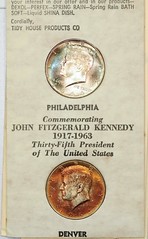 Here is a scan of a 5.25" x 2.75" packet from Tidy House Products Co, an Omaha Nebraska manufacturer of household cleaning products that was acquired by Pillsbury in 1960. Evidently, Tidy House did this often, offering silver dollars and half dollar pairs as sales promotional items which they sold for a small premium.
Here is a scan of a 5.25" x 2.75" packet from Tidy House Products Co, an Omaha Nebraska manufacturer of household cleaning products that was acquired by Pillsbury in 1960. Evidently, Tidy House did this often, offering silver dollars and half dollar pairs as sales promotional items which they sold for a small premium.
The coins are believed to have come from sealed mint bags which the company acquired from the mint. The thing that makes these coins even more special is the fact that they used high sulfur paper in the packages they came in and over time the coins acquired a wonderful tone.
The Kennedy Half sets were $10.95 which included shipping and handling.
These coins are not that easy to find these days but a few show up on eBay from time to time. Just search "TIDY" in coins and paper money and they will show up when available.
Sadly, I can not find much information on this company and its promotions so I have no idea how many they actually sold or how long they were in business. If you have any information on Tidy House Products I would be happy to hear from you.
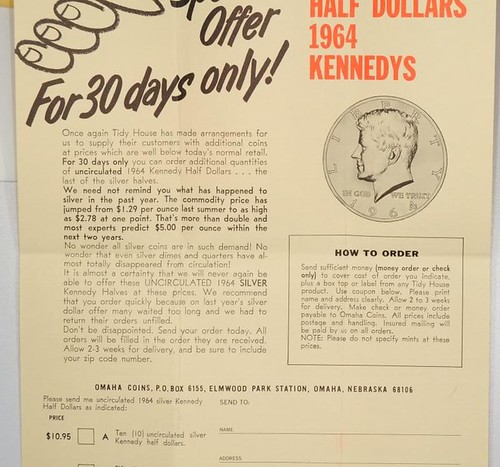
THE BEST ANTI-PENNY RANT EVER?
Regular readers of The E-Sylum will recognize I have written, intelligently I hope, on the uselessness of a one-cent coin. Low denomination coins have been abolished in far-sighted countries, like Australia, and is being strongly considered by Canada. Perhaps there is a growing concern among far-thinking Americans that continuing to strike one-cent coins, whose economic usefulness has long since diminished, is not a wise thing to do.
I have uncovered a blog this week sponsored by a group called Freakonomics. They achieved a real coup by having their video rant placed on the New York Times web site.
Its theme is "I hate pennies." I don't endorse that theme. I love and collect U.S. cents as a qualified collectable. I don't "hate" them. This guy -- John Green -- does, to the extreme. New York journalist Stephen J. Dubner says this guy is good at what he does (ranting). Agreed!
No matter what your opinion on the status of the cent coin, you will be entertained by his rant. Click on this and click on the video: The Best Anti-Penny Rant Ever? (freakonomics.blogs.nytimes.com/2010/09/09/the-best-anti-penny-rant-ever/)
NOTES FROM E-SYLUM READERS: SEPTEMBER 12, 2010
Regarding the American Numismatic Association's planned seminar in Carson City, Nevada, Myron Xenos writes:
The Carson City Museum has a pretty complete set of CC coins, but good luck trying to see them. When I was there, they were in a stand-up display 10 feet behind a wrought-iron gate. You would have needed binoculars to enjoy them. As far as CC coins are concerned, you can see more at the ANA in Chicago next year.
On a better note, those of us who are protectors of the Second Amendment are treated to what I consider to be the finest display of weapons I have ever seen, including a brass Gatling gun and some pistols I could have only imagined.
Howard A. Daniel III writes:
"The United Future World Currency project is another useless scheme by those people who believe something like the United Nations can become the world's government."
To read the earlier E-Sylum article, see: ARTICLE PROFILES UNITED FUTURE WORLD CURRENCY PROJECT COORDINATOR (www.coinbooks.org/esylum_v13n36a19.html)
Well, someone at the Journal of Physical Education and Sport Management must have found these during a web search, This week I received this email: "We received a manuscript titled; Anthropometric characteristics, somatotyping and body composition of Volleyball and Basketball players. I wish to inquire if you can create time to review this manuscript."
Who, me? Are they so hard up for qualified reviewers that they'll spam random web contacts without even reading the web pages? Who writes the articles for this journal? Monkeys with typewriters? -Editor
Dave Bowers forwarded a copy of philatelic literature dealer Leonard H. Hartmann's latest Friends of the Bibliopole price list (September 6, 2010). In it were a few titles on forgery that may be of interest to numismatists.
We have just added to stock two new Forgery titles by Joe Nickell and still have a few copies of his long out of print 1990 book. These books are informative and a joy to read but they are not philatelic
Real or Fake: Studies in Authentication. 2009, 256 pages, cloth with dj, $35.00
Detecting Forgery: Forensic Investigation on Documents by Joe Nickell, 2005, 240 pages, card, $19.95
Pen, Ink and Evidence, 1990, 304 pages, in color, cloth, limited stock, $77.50
For more information, see: www.pbbooks.com .
Alan V. Weinberg writes:
The latest online Coin World indicates that the long running dispute (since 2007!) involving dealers Stu Levine, Ken Goldman and the Professional Numismatists Guild will be heard, and open to the public, at the forthcoming late September Long Beach Ca show.
This should be interesting, particularly since the previous secretive decisions of the PNG, of absolutely no benefit to the collecting public or non-member dealers, will be open to public scrutiny and, hopefully, public imput. The PNG has no business keeping under wraps for so many years, on penalty of suspension or expulsion as happened in this case, their adjudicated findings on behavior in their ranks. Not only does this cheat the entire hobby but it leads to unfounded rumors being spread.
The PNG was wrong, notwithstanding their "rules" on secrecy, and an Appeals Court has said that. It takes years but sometimes our system exhibits common sense.
THE BOOK BAZARRE
VIDEO ON EUROPEAN MONETARY UNIFICATIONS RELEASED
Georges Depeyrot writes:
I have the great pleasure to inform you that the 2010 video supporting the European monetary unifications, from Antiquity to modern times (EMU) application for the creation of a European COST network is now on the website. You can find it at www.emu-cost.net/pages/emu_presentation.html

ARABIC COINS OF THE MIDDLE AGES FOUND IN GERMANY
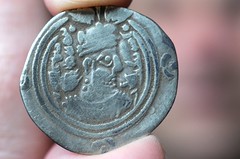 It's not often that archeologists find ancient coins with Arabic engravings in Germany. A recent such discovery, however, may prove that the Baltic Sea coast had trading ties to the Middle East as far back as the 7th century.
It's not often that archeologists find ancient coins with Arabic engravings in Germany. A recent such discovery, however, may prove that the Baltic Sea coast had trading ties to the Middle East as far back as the 7th century.
Finding old coins in the ground is no great trick in Germany. Indeed, there are small armies of hobby historians who, armed with handheld metal detectors, comb fields and forests for bits of old metal, often flouting laws prohibiting such treasure hunting. Roman coins, a bit of Celtic spare change and the occasional thaler of more recent provenance are hardly a rarity.
Recently, though, scientists in the eastern German state of Mecklenburg-Western Pomerania discovered a more meaningful treasure: silver coins with Arabic engravings, silver jewellery and bars. The find proves the existence of a trade route connecting Middle Eastern regions with the Baltic Sea coast dating back to the early Middle Ages.
The coins, the oldest of which dates to 610, were found in a field near the German town of Anklam, not far from the Polish border, at the end of August. "The discovery of Arabian coins on the Baltic Sea proves that global trade has existed for more than 1,200 years," Fred Ruchhöft, a historian from nearby Greifswald University, told the German news agency dpa.
Scientists cannot say with certainty why the items were buried. "It was probably out of fear of being robbed that motivated the Slav to bury the treasure in the field," Ruchhöft said.
For about 200 grams of silver, which was the weight of the treasure, the owner could have bought four oxen, or, with skillful trading, acquired a slave.
To read the complete article, see: Unearthed Treasure Proves Early East-West Trade Route (www.spiegel.de/international/germany/0,1518,716001,00.html)
LIVING SOLDIER TO RECEIVE MEDAL OF HONOR
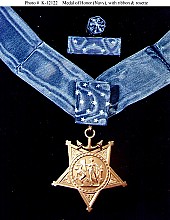 President Barack Obama awards Medal of Honor to a living soldier. Sgt. Salvatore Giunta is the brave man who will receive the award making him the first living recipient of the Medal of Honor since Vietnam.
President Barack Obama awards Medal of Honor to a living soldier. Sgt. Salvatore Giunta is the brave man who will receive the award making him the first living recipient of the Medal of Honor since Vietnam.
Giunta will receive the medal for his actions on October 25, 2007 when then Army Staff Sgt. Guinta, 22, ran straight into an ambush to aid three fellow wounded soldiers during an attack by Taliban fighters in the Korengal Valley in Afghanistan.
During the attack, two of the paratroopers died, and many of the others were seriously wounded. However, thanks to Giunta's outstanding bravery, the toll of the attack was much lower than it would have been.
There have been six posthumous medals awarded for service in Iraq and Afghanistan, which is a small number compared to the number of medals awarded in other conflicts. There has been some controversy over why there have been so few medals awarded.
To read the complete article, see: Rare Medal of Honor Awarded to Living Soldier by President Barack Obama (news.gather.com/viewArticle.action?articleId=281474978509955)
ARTICLE: DE LA RUE STAFF FALSIFIED BANKNOTE TEST RESULTS
Some De La Rue staff "deliberately falisfied" tests that forced it to halt banknote shipments and warn on profits, the world's biggest banknote printer said.
Shares in the company, which makes paper for more than 150 currencies around the world, fell a further 5pc on Tuesday after the announcement.
They have now fallen more than 28pc since June when De La Rue suspended part of its operations at its largest plant after "quality and production irregularities" without giving details.
"Banknote paper specifications have a large number of detailed parameters and the investigation has found in certain cases that a small number of them have fallen marginally short of specification."
It gave no indication of how many staff were involved.
The investigation into production irregularities at its printing plant in Overton, Hampshire are continuing, the board said.
De La Rue said all paper production is now within specification and it is ready to resume supply of fully compliant paper as soon as customers agree.
It did not name the customers.
The company remained confident that neither the "physical security nor the security features in the paper have been compromised".
To read the complete article, see:
De La Rue staff 'deliberately falsified' banknote tests
(www.telegraph.co.uk/finance/newsbysector/epic/
dlar/7986964/De-La-Rue-staff-deliberately-falsified-banknote-tests.html)
To read a related article in The Guardian, see: De La Rue faces Serious Fraud Office inquiry over 'falsified documents' (www.guardian.co.uk/business/2010/sep/07/de-la-rue-serious-fraud-office)
MAN'S DEFENSE: PHONY MONEY IS FOR ARTISTIC ENDEAVOR
St. Lucie County Sheriff's Office detectives who raided Ronald Jensen's apartment in June 2009 found a total of $1,680 in counterfeit bills, including burnt $20 bills inside the toilet bowl and a stack of folded $20 bills on the back of the toilet, reports TCPalm.com.
On Friday, Jensen, 53, had his day in court.
Jensen's defense: He argued the fake $20 bills sheriff's deputies found in his house were for a music video he was making to protest Andrew Jackson's signing of the Indian Removal Act of 1830 that forced Native Americans to move from their homelands in the Southeast United States to reservations in Oklahoma, the so-called “Trail of Tears,” according to TCPalm.com.
He planned to burn fake $20 bills and flush them down the toilet in the video, reports TCPalm.com.
Claiming to be the son of a Cherokee Indian, Jensen said, “I wanted to demean Andrew Jackson the way he demeaned my people. ... I'm an artist, and I was exercising my freedom of speech. ... I've been charged with a crime I didn't commit,” according to TCPalm.com.
But St. Lucie County Circuit Judge James W. McCann wasn't buying Jensen's story: He sentenced him to 18 months in prison followed by five years of probation.
Nice try.
To read the complete article, see:
Man's defense: Phony money is for artistic endeavor
(weblogs.sun-sentinel.com/news/specials/weirdflorida/blog/2010/09/
mans_defense_phony_money_is_fo_1.html)
FEATURED WEB SITE: BARBERHALF.COM
This week's Featured Web Site is devoted to Barber Half Dollars.

The Barber Half Dollar was introduced in 1892 along with the similarly designed dime and quarter dollar coins. The half dollar featured the same basic design, consisting of Liberty on the obverse and an eagle on the reverse. The series was produced until 1915, when it was replaced by the popular Walking Liberty Half Dollar. The Barber Half Dollar is traditionally one of the less popular series to collect, but has been attracting more attention recently and original pieces have become increasingly difficult to find in any grade.
barberhalf.com
